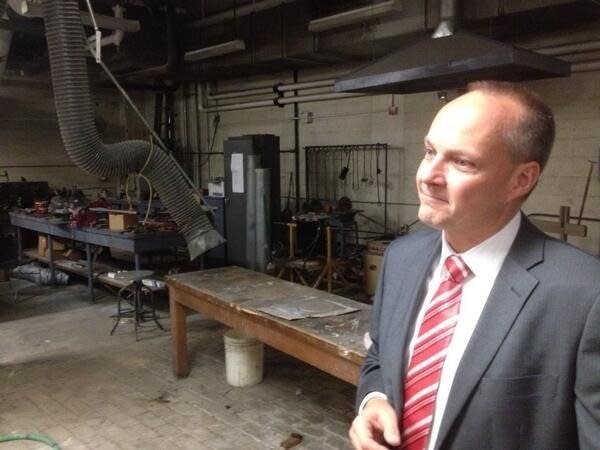University of Minnesota pushes science in facilities request
Go Deeper.
Create an account or log in to save stories.
Like this?
Thanks for liking this story! We have added it to a list of your favorite stories.

As University of Minnesota officials gear up to ask the Legislature for $233 million in funding to renovate and construct buildings, they're driving home one theme:
It's all about STEM -- Science, Technology, Engineering and Math.
University government relations adviser Jason Rohloff told reporters during a campus facilities tour today that all but one of the major renovation and construction projects are connected to those fields.
Increased production of science-related degrees is one of the performance targets the U needs to hit to get all of its state funding.
Turn Up Your Support
MPR News helps you turn down the noise and build shared understanding. Turn up your support for this public resource and keep trusted journalism accessible to all.
"In order to do that, you need laboratory space that is suitable," Rohloff said. "We're hoping for support from the Legislature to deliver what they've asked us to do -- and what we're hearing from industry as well."
At the moment, U officials say, outdated facilities are impeding progress in science research and teaching -- even in those areas where the U excels.
University officials showed reporters several projects they're hoping to get renovations funding for:
The mechanical engineering department building (part of the system-wide maintenance plan);
Tate Laboratory Building;
Two labs -- the U's bee research facility and Aquatic Invasive Species Center.
(The two other big projects are at other U of M campuses: the Chemical Sciences and Advanced Materials Building in Duluth; and the Campus Wellness Center in Crookston.)
The common theme: Spaces are cramped, outmoded -- and often not up to code for building safety.
University officials say that has hindered some research and possibly harmed recruitment.
Mechanical engineering

First off was the mechanical engineering building, which needs $34.6 million -- by far the largest chunk of the renovation budget.
Two-thirds of the facility is in a 1948 building that hasn't been renovated since then, said department head Uwe Kortshagen.
During the media tour he showed a welding lab area that will be fully rehabbed and reorganized.
"If you look around, you see the infrastructure isn't exactly appealing. When we bring new students here to recruit them to the University of Minnesota, we don't exactly take them to this part of the building."
Kortshagen also showed an engine lab where researchers are limited in what they can study about combustion, because safety rules prohibit the space from handling large amounts and certain types of hazardous fuel.
Kortshagen pointed out a section of the lab he said would be great as background for "a movie set in the 1950s."
He also showed an electrical system with components so old it's hard to find parts for them -- a situation that could leave large parts of the building dark if the system ever goes on the fritz.
He told reporters:
"Once [the equipment] breaks, there's hardly any chance we'll be able to repair it."
(To those with an eye on jobs, Kortshagen stressed that about 80 percent of his students find a position within three months of graduation

-- and most stay in Minnesota to work for companies such as 3M, Medtronic and Cargill.
Tate Laboratory of Physics
The building carries some historical significance, and Ronald Poling, head of the school of physics and astronomy, said the Tate was seen as "a very innovative, very exciting building."
But that was in 1928. It needs $57 million in state funding for renovations that will, among other things, create new research and lecture spaces.
It'll serve not just physics and astronomy programs, but also the School of Earth Sciences, which is moving in to work more closely with physicists and astronomers.
Bee Research Facility
The U's St. Paul campus is home to a well-known national hub for bee research -- the 800-square-foot Bee Research Facility, run by bee guru Marla Spivak.
That's right: 800 square feet for Spivak and the research needs of nine postgraduate students.

Spivak said nothing really has its own place; the group has to constantly shift materials and research equipment as their priorities change.
"It's super inefficient to work this way," she said. "There's not enough room to do everything we need to do."
Their research isn't exactly an obscure niche. They're looking into bee health and behavior, a hot topic now that honeybees have been dying off.
They're hoping for a 10,000-foot facility at a cost of $3 million.
Minnesota Aquatic Invasive Species Research Center
Associate Director Becca Nash showed reporters where the center's digs -- a 1911 vocational training facility to teach the repair of tractors and farm implements.
She told reporters:
"We are doing our research in a big garage."
The facility needs about $6 million in renovations -- much of it just to keep going.
Nash said the life-support systems for fish -- such as heating, aeration and water filtration -- are unstable, and the facility has no warning

devices or electrical backup system.
Nash told the group:
"If there's a systemic failure, we could lose months if not years of research, equating to millions of dollars of research. .. We're terrified that the well is going to break down any day."
Nash also said her colleagues can't do research on adult Asian carp, zebra mussels and new invasive species because they don't have the proper facilities.
Also on the tour, U officials also discussed the need for $30 million in state funding for construction of the proposed Microbial Sciences Research Building near the Cargill Building on the St. Paul campus.


